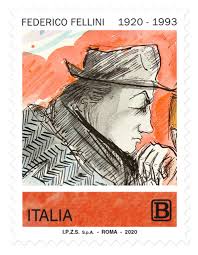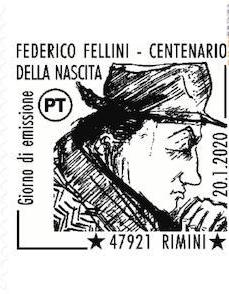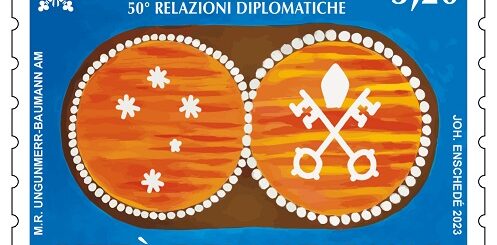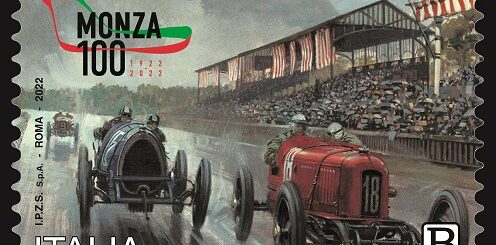POSTE ITALIANE 2^ emissione del 20 Gennaio 2020 di un francobollo dedicato a Federico Fellini, nel centenario della nascita
POSTE ITALIANE 2^ emissione del 20 Gennaio 2020 di un francobollo dedicato a Federico Fellini, nel centenario della nascita

Il Ministero dello Sviluppo ha emesso il 20 gennaio 2020 un francobollo ordinario appartenente alla serie tematica “le Eccellenze italiane dello spettacolo” dedicato a Federico Fellini, nel centenario della nascita, relativo al valore della tariffa B, corrispondente ad €1.10.
- data / date 20 gennaio 2020
- dentellatura / serration 11
- stampa / printing rotocalcografia
- tipo di carta / paper type carta patinata gommata, adesiva
- stampato / printed I.P.Z.S. Roma
- tiratura / edition 500.000
- fogli / sheet 45
- dimensioni / dimension 30 x 40 mm
- costo / price B = € 1,10
- bozzettista/ designer a cura del Centro Filatelico della Direzione Operativa dell’Istituto Poligrafico e Zecca dello Stato S.p.A.
- num. catalogo/catalog num. Michel 4184 YT 3945 UNIF 4027
Federico Fellini (Rimini, 20 gennaio 1920 – Roma, 31 ottobre 1993) è stato un regista, sceneggiatore, fumettista e scrittore italiano.
Considerato uno dei maggiori registi della storia del cinema, nell’arco di quasi quarant’anni – da Lo sceicco bianco del 1952 a La voce della Luna del 1990 – ha “ritratto” in decine di lungometraggi una piccola folla di personaggi memorabili. Definiva se stesso “un artigiano che non ha niente da dire, ma sa come dirlo“. Ha lasciato opere ricche di satira e velate di una sottile malinconia, caratterizzate da uno stile personale e visionario. I titoli dei suoi più celebri film – La strada, Le notti di Cabiria, La dolce vita, 8½ e Amarcord – sono diventati famosi, in tutto il mondo.
I suoi film La strada, Le notti di Cabiria, 8½ e Amarcord hanno vinto l’Oscar al miglior film straniero. Candidato 12 volte al Premio Oscar, per la sua attività da cineasta gli è stato conferito nel 1993 l’Oscar alla carriera. Ha vinto inoltre due volte il Festival di Mosca (1963 e 1987), la Palma d’oro al Festival di Cannes nel 1960 e il Leone d’oro alla carriera alla Mostra del Cinema di Venezia nel 1985.
Infanzia e giovinezza
Federico Fellini nacque a Rimini il 20 gennaio 1920 da una famiglia modesta. Il padre, Urbano Fellini (1894-1956), era un rappresentante di liquori, dolciumi e generi alimentari originario di Gambettola, una cittadina sita a poco più di 20 km ad ovest di Rimini, in direzione di Forlì, mentre la madre, Ida Barbiani (1896-1984), era una casalinga originaria di Roma, del rione Esquilino. Fellini segue studi regolari, frequentando il Ginnasio-Liceo classico “Giulio Cesare”] di Rimini dal 1930 al 1938. Da adolescente rivela già il proprio talento nel disegno, che manifesta sotto forma di vignette e caricature di compagni e professori. Attentissimo a chi gli stava intorno, spesso ne imitava i gesti.
Il suo disegnatore preferito era lo statunitense Winsor McCay, inventore del personaggio di «Little Nemo». Ispirandosi al celebre personaggio, nella sua camera da letto aveva costruito con la fantasia un mondo inventato, nel quale immaginava di ambientare le storie che voleva vivere e raccontare e vedere al cinema. Ai quattro montanti del letto aveva dato i nomi dei quattro cinema di Rimini: da lì, prima di addormentarsi, prendevano forma le sue storie immaginifiche. Fellini, fin dall’età di sedici anni, mostrava una grande attrazione per il cinema: infatti, nel suo libro Quattro film, descrive che, tra gli anni 1936 e 1939, usciva di casa senza permesso dei genitori ed entrava nei cinema nella sua città. A quell’età non pensava ancora di fare il regista, ma qualcosa a metà tra lo scrittore e l’illustratore.
Già prima di terminare la scuola, nel 1938, Fellini invia le proprie creazioni ai giornali. La prestigiosa «Domenica del Corriere» gli pubblica una quindicina di vignette nella rubrica “Cartoline del pubblico” (la prima appare sul numero del 6 febbraio 1938). Il settimanale politico-satirico fiorentino «Il 420», edito da Nerbini, gli pubblica numerose vignette e rubrichette umoristiche sino alla fine del 1939. Agli inizi dello stesso anno (4 gennaio 1939) Fellini si è trasferito a Roma con la scusa di frequentare l’Università, in realtà per realizzare il desiderio di dedicarsi alla professione giornalistica.
Gli esordi
Fellini giunge nella capitale seguito dalla madre Ida, che nella città ha i suoi parenti, e dai due fratelli Riccardo e la piccola Maddalena; prende alloggio in via Albalonga 13, fuori porta San Giovanni (nel quartiere Appio-Latino). Si iscrive alla Facoltà di Giurisprudenza. Le prime esperienze del giovane Fellini rivelano che il suo obiettivo professionale non era tanto diventare avvocato (non sosterrà mai un esame) quanto intraprendere il lavoro di giornalista. Federico Fellini esordisce infatti, pochi mesi dopo il suo arrivo a Roma, nell’aprile 1939, sul Marc’Aurelio, la principale rivista satirica italiana, nata nel 1931 e diretta da Vito De Bellis. Collabora come disegnatore satirico, ideatore di numerose rubriche (tra le quali È permesso…?), vignettista e autore delle celebri “Storielle di Federico”, divenendo una firma di punta del quindicinale. Il suo principale referente in questa fase è il disegnatore satirico e illustratore cinematografico Enrico De Seta.
Il successo nel Marc’Aurelio si traduce in buoni guadagni e inaspettate offerte di lavoro. Fellini fa conoscenza con personaggi a quel tempo già noti. Comincia a scrivere copioni e gag di sua mano. Collabora ad alcuni film di Erminio Macario]: Imputato, alzatevi! e Lo vedi come sei… lo vedi come sei? del 1939; Non me lo dire! e Il pirata sono io! del 1940; scrive le battute per gli spettacoli dal vivo di Aldo Fabrizi, nell’ambito di un’amicizia consolidata prima dell’esordio nel mondo dello spettacolo.
Fellini e la radio
Nel 1941 viene chiamato a collaborare con l’Ente Italiano Audizioni Radiofoniche (EIAR), avviando una breve stagione come autore radiofonico. Per quanto meno nota rispetto all’opera cinematografica, l’attività radiofonica di Fellini è importante poiché segna il suo esordio nel mondo dello spettacolo, nonché l’inizio del sodalizio artistico e affettivo con Giulietta Masina.
In questi anni Fellini firma una novantina di copioni, tra presentazioni di programmi musicali, riviste radiofoniche, fino alla celebre serie di ventiquattro radioscene Cico e Pallina. Trasmessa saltuariamente all’interno del programma di varietà Il terziglio fra il 1942 e il 1943, la serie si incentra sulle avventure di due giovani sposi dall’animo semplice e puro.
Il ruolo di Cico è di Angelo Zanobini, mentre Pallina è interpretata da una giovane attrice di rivista, Giulietta Masina, che Fellini conosce nel 1942 e che diventerà sua compagna inseparabile e interprete nei suoi film. Tra l’ampia produzione radiofonica di questi anni, anche le riviste scritte con Ruggero Maccari (tra le quali Vuoi sognare con me con Paolo Poli, Riccardo Garrone, Gisella Sofio e Sandra Milo) e la toccante Una lettera d’amore (1942), incentrata su una giovane fanciulla analfabeta che spedisce fogli bianchi al fidanzato e che lascia presagire la poesia di successivi personaggi cinematografici come Gelsomina e Cabiria.
Nel luglio 1943 Giulietta presenta Federico ai propri genitori. Dopo l’8 settembre 1943, quando il proclama di Badoglio rese pubblico l’armistizio con gli Alleati, Fellini, invece di rispondere alla chiamata alla leva, convola a nozze con lei il 30 ottobre. Nei primi mesi di matrimonio vivono insieme nella casa della zia di Giulietta, Giulia, di famiglia benestante (i suoi congiunti possedevano a Milano il calzaturificio «Di Varese» e Giulia era vedova di Eugenio Pasqualin, preside del Liceo Tasso della capitale). Giulietta e Federico hanno di lì a poco un figlio, Pier Federico detto Federichino, nato il 22 marzo 1945 e morto appena un mese dopo la nascita, il 24 aprile.
Nel 1950 Fellini esordisce alla regia con Luci del varietà, che dirige con Alberto Lattuada. Oltre alla regia, i due cineasti si cimentano anche come produttori grazie a un accordo basato su una formula di cooperativa. Il soggetto della pellicola è un tema che diventerà un topos narrativo di Fellini: il mondo dell’avanspettacolo e la sua decadenza. Sul set si respira aria ilare e distesa con Lattuada che dirige principalmente i lavori ma con un Fellini sempre presente e attivo.
Nonostante il film riceva giudizi positivi da parte della critica, non riscuote gli sperati successi commerciali, piazzandosi come incasso al sessantacinquesimo posto tra i film italiani durante la stagione 1950-51. Il pessimo esito finanziario della pellicola lascia un segno pesante sui patrimoni personali di Fellini e Lattuada e ciò contribuisce a raffreddare definitivamente i rapporti tra i due.
L’esordio assoluto come regista: Lo sceicco bianco
Due anni dopo Le luci del varietà, Fellini giunge all’esordio assoluto come regista, con Lo sceicco bianco, con Antonioni coautore del soggetto, Flaiano coautore della sceneggiatura e una grande interpretazione di Alberto Sordi, esempio della capacità di Fellini di valorizzare gli attori più amati dal pubblico. È il momento cruciale nella carriera felliniana: il momento nel quale l’attività di regista prende il sopravvento su quella di sceneggiatore. La gestione delle riprese da parte di Fellini si realizza in una continua rivisitazione della sceneggiatura con l’arricchimento di situazioni e la dilatazione dei tempi. Questo suo modo di operare lo porterà ad alcuni contrasti con il direttore di produzione Enzo Provenzale.
Gli anni cinquanta sono caratterizzati da profondi cambiamenti nella società e in particolare nell’Italia che si avvia verso l’industrializzazione. I film di Fellini girati in questo periodo nascono proprio da questo contesto. Dopo Luci del varietà il regista gira I vitelloni, che racconta la vita di provincia di un gruppo di amici a Rimini. Questa volta il film ha un’accoglienza entusiastica. Alla Mostra del cinema di Venezia, dove viene presentato il 26 agosto 1953, l’opera conquista il Leone d’argento. La fama di Fellini si espande per la prima volta all’estero, il film è infatti campione di incassi in Argentina e riscuote un buon successo anche in Francia, Stati Uniti e Inghilterra.
Il grande successo internazionale arriva per Fellini grazie al film La strada, girato nel 1954. L’idea del film si ha intorno al 1952 quando Fellini è alle prese con il montaggio de Lo sceicco bianco. Per motivi strettamente legati alla produzione è però costretto a ritardare il progetto e a girare prima I vitelloni e l’episodio Agenzia matrimoniale, ma in testa ha già chiaramente l’idea che lo porterà alla realizzazione della successiva opera.
Oramai il grande successo e la fama della critica nazionale ed internazionale che consacra Federico Fellini tra i più grandi autori e registi italiani. Ecco l’elenco dei maggiori film da lui diretti.
Regista e sceneggiatore
- Luci del varietà, co-regia di Alberto Lattuada (1950)
- Lo sceicco bianco (1952)
- I vitelloni (1953)
- Agenzia matrimoniale, episodio di L’amore in città (1953)
- La strada (1954)
- Il bidone (1955)
- Le notti di Cabiria (1957)
- La dolce vita (1960)
- Le tentazioni del dottor Antonio, episodio di Boccaccio ’70 (1962)
- 8½ (1963)
- Giulietta degli spiriti (1965)
- Toby Dammit, episodio di Tre passi nel delirio (1968)
- Block-notes di un regista (1969), documentario televisivo
- Fellini Satyricon (1969)
- I clowns (1970), documentario televisivo
- Roma (1972)
- Amarcord (1973)
- Il Casanova di Federico Fellini (1976)
- Prova d’orchestra (1979)
- La città delle donne (1980)
- E la nave va (1983)
- Ginger e Fred (1986)
- Intervista (1987), documentario televisivo
- La voce della Luna (1990)
Nella primavera del 1993, qualche mese prima di morire, Fellini riceve il suo quinto Oscar, alla carriera. Federico Fellini si spegne a Roma per un infarto il 31 ottobre 1993 all’età di 73 anni.
Se sei interessato all’acquisto di questo francobollo lo puoi acquistare al prezzo di €1.50. Inviami una richiesta alla email: protofilia1@gmail.com
On January 20, 2020, the Ministry of Development issued an ordinary stamp belonging to the thematic series “The Italian Excellencies of the Show” dedicated to Federico Fellini, on the centenary of his birth, relating to the value of tariff B, corresponding to € 1.10.
- data / date 20 gennaio 2020
- dentellatura / serration 11
- stampa / printing rotocalcografia
- tipo di carta / paper type carta patinata gommata, adesiva
- stampato / printed I.P.Z.S. Roma
- tiratura / edition 500.000
- fogli / sheet 45
- dimensioni / dimension 30 x 40 mm
- costo / price B = € 1,10
- bozzettista/ designer a cura del Centro Filatelico della Direzione Operativa dell’Istituto Poligrafico e Zecca dello Stato S.p.A.
- num. catalogo/catalog num. Michel 4184 YT 3945 UNIF 4027
Federico Fellini (Rimini, 20 January 1920 – Rome, 31 October 1993) was an Italian director, screenwriter, cartoonist and writer.
Considered one of the greatest directors in the history of cinema, over almost forty years – from The White Sheikh of 1952 to The Voice of the Moon in 1990 – he has “portrayed” a dozen of memorable characters in dozens of feature films. He called himself “a craftsman who has nothing to say, but knows how to say it”. He left works full of satire and veiled with a subtle melancholy, characterized by a personal and visionary style. The titles of his most famous films – La strada, The nights of Cabiria, La dolce vita, 8½ and Amarcord – have become famous all over the world.
His films The Road, The Nights of Cabiria, 8½ and Amarcord won the Oscar for best foreign film. Nominated 12 times for the Oscar, for his work as a filmmaker he was awarded a career Oscar in 1993. He also twice won the Moscow Film Festival (1963 and 1987), the Palme d’Or at the Cannes Film Festival in 1960 and the Golden Lion for Lifetime Achievement at the Venice Film Festival in 1985.
Childhood and youth
Federico Fellini was born in Rimini on January 20, 1920 from a modest family. His father, Urbano Fellini (1894-1956), was a representative of liqueurs, sweets and foodstuffs originally from Gambettola, a town located just over 20 km west of Rimini, in the direction of Forlì, while his mother, Ida Barbiani (1896-1984), was a housewife originally from Rome, from the Esquilino district. Fellini follows regular studies, attending the “Giulio Cesare” high school in Rimini from 1930 to 1938. As a teenager he already reveals his talent in drawing, which he manifests in the form of cartoons and caricatures of classmates and professors. Attentive to those around him, he often imitated his gestures.
His favorite cartoonist was the American Winsor McCay, inventor of the character of “Little Nemo”. Inspired by the famous character, in his bedroom he had built an invented world with his imagination, in which he imagined to set the stories he wanted to live and tell and see in the cinema. He gave the four pillars of the bed the names of the four cinemas in Rimini: from there, before falling asleep, his imaginative stories took shape. Fellini, from the age of sixteen, showed a great attraction for cinema: in fact, in his book Quattro film, he describes that, between the years 1936 and 1939, he left the house without parental permission and entered the cinemas in his city . At that age he still did not think of being a director, but something halfway between the writer and the illustrator.
Already before finishing school, in 1938, Fellini sent his creations to the newspapers. The prestigious «Domenica del Corriere» publishes about fifteen cartoons in the “Postcards of the public” section (the first appears in the issue of 6 February 1938). The political-satirical Florentine weekly “Il 420”, published by Nerbini, published numerous humorous cartoons and rubricettes until the end of 1939. At the beginning of the same year (January 4, 1939) Fellini moved to Rome with the excuse of attending l ‘University, actually to fulfill the desire to devote himself to the journalistic profession.
The beginnings
Fellini arrives in the capital followed by his mother Ida, who has relatives in the city, and by the two brothers Riccardo and little Maddalena; it takes accommodation in via Albalonga 13, outside Porta San Giovanni (in the Appio-Latino district). He enrolled in the Faculty of Law. The first experiences of the young Fellini reveal that his professional goal was not so much to become a lawyer (he will never take an exam) but to undertake the job of journalist. In fact, Federico Fellini made his debut a few months after his arrival in Rome, in April 1939, on Marc’Aurelio, the main Italian satirical magazine, born in 1931 and directed by Vito De Bellis. He collaborates as a satirical designer, creator of numerous sections (including Is it allowed …?), Cartoonist and author of the famous “Storielle di Federico”, becoming a signature of the fortnightly. Its main contact at this stage is the satirical designer and film illustrator Enrico De Seta.
Success in Marc’Aurelio translates into good earnings and unexpected job offers. Fellini becomes acquainted with characters already known at the time. He starts writing scripts and gags in his own hand. Collaborate on some films by Erminio Macario]: Defendant, get up! and do you see it as you are … do you see it as you are? of 1939; Do not tell me! and the pirate is me! from 1940; he writes the lines for Aldo Fabrizi’s live shows, as part of a consolidated friendship before his debut in the world of entertainment.
Fellini and the radio
In 1941 he was called to collaborate with the Italian Radio Auditions Authority (EIAR), starting a short season as a radio author. Although less known than the cinematographic work, Fellini’s radio activity is important because it marks his debut in the world of entertainment, as well as the beginning of the artistic and emotional partnership with Giulietta Masina.
In these years Fellini signs about ninety scripts, including presentations of musical programs, radio magazines, up to the famous series of twenty-four radio shows Cico and Pallina. Occasionally broadcast within the Il terziglio variety program between 1942 and 1943, the series focuses on the adventures of two young newlyweds with a simple and pure soul.
The role of Cico is by Angelo Zanobini, while Pallina is played by a young magazine actress, Giulietta Masina, whom Fellini met in 1942 and who will become his inseparable companion and interpreter in his films. Among the large radio production of these years, also the magazines written with Ruggero Maccari (among which you want to dream with me with Paolo Poli, Riccardo Garrone, Gisella Sofio and Sandra Milo) and the touching A love letter (1942), centered on a young illiterate girl who sends blank sheets to her boyfriend and who foreshadows the poetry of subsequent film characters such as Gelsomina and Cabiria.
In July 1943 Giulietta introduced Federico to his parents. After September 8, 1943, when the proclamation of Badoglio made the armistice with the Allies public, Fellini, instead of answering the call to the draft, enters a wedding with her on October 30. In the first months of marriage, they lived together in the home of Juliet’s aunt, Giulia, from a wealthy family (her relatives owned the Di Varese shoe factory in Milan and Giulia was the widow of Eugenio Pasqualin, principal of the Liceo Tasso in the capital). Giulietta and Federico soon have a son, Pier Federico called Federichino, born on March 22, 1945 and died just a month after his birth, on April 24.
In 1950 Fellini made his directorial debut with Luci del Vari, which he directed with Alberto Lattuada. In addition to directing, the two filmmakers also compete as producers thanks to an agreement based on a cooperative formula. The subject of the film is a theme that will become a narrative topos by Fellini: the world of the avanspectacle and its decadence. On the set you can breathe hilarious and relaxed air with Lattuada who directs mainly the works but with a Fellini always present and active.
Although the film receives positive reviews from critics, it does not receive the hoped for commercial success, placing itself as a taker in sixty-fifth place among Italian films during the 1950-51 season. The bad financial outcome of the film leaves a heavy mark on the personal assets of Fellini and Lattuada and this contributes to definitively cooling the relationships between the two.
The absolute debut as a director: The White Sheikh
Two years after The lights of the variety, Fellini reached his absolute debut as a director, with Lo sceicco bianco, with Antonioni co-author of the subject, Flaiano co-author of the screenplay and a great interpretation by Alberto Sordi, an example of Fellini’s ability to enhance the actors more loved by the public. It is the crucial moment in Fellini’s career: the moment in which the activity of director takes over that of screenwriter. The management of the filming by Fellini is carried out in a continuous review of the script with the enrichment of situations and the expansion of the times. This way of operating will lead him to some disagreements with the production manager Enzo Provenzale.
The fifties are characterized by profound changes in society and in particular in Italy which is moving towards industrialization. Fellini’s films shot in this period are born precisely from this context. After Luci del Vari, the director turns I vitelloni, which tells the provincial life of a group of friends in Rimini. This time the film has an enthusiastic reception. At the Venice Film Festival, where it is presented on August 26, 1953, the work wins the Silver Lion. Fellini’s fame expands abroad for the first time, the film is in fact a box office hit in Argentina and is also very successful in France, the United States and England.
The great international success arrives for Fellini thanks to the film La strada, shot in 1954. The idea of the film was around 1952 when Fellini was grappling with the editing of Lo sceicco bianco. For reasons strictly related to production, however, he was forced to delay the project and shoot I vitelloni and the marriage agency episode first, but in his head he already clearly has the idea that will lead him to the realization of the next work.
By now the great success and fame of the national and international critics who consecrate Federico Fellini among the greatest Italian authors and directors. Here is the list of the major films he directed.
Director and screenwriter
• Variety lights, co-directed by Alberto Lattuada (1950)
• The white sheikh (1952)
• I vitelloni (1953)
• Marriage agency, episode of Love in the city (1953)
• The road (1954)
• The bin (1955)
• The nights of Cabiria (1957)
• La dolce vita (1960)
• The temptations of Doctor Antonio, episode of Boccaccio ’70 (1962)
• 8½ (1963)
• Juliet of the spirits (1965)
• Toby Dammit, episode of Three steps in delirium (1968)
• Block-notes of a director (1969), television documentary
• Fellini Satyricon (1969)
• The clowns (1970), television documentary
• Rome (1972)
• Amarcord (1973)
• Federico Fellini’s Casanova (1976)
• Orchestra rehearsal (1979)
• The city of women (1980)
• And the ship goes (1983)
• Ginger and Fred (1986)
• Interview (1987), television documentary
• The voice of the Moon (1990)
In the spring of 1993, a few months before his death, Fellini received his fifth career Oscar. Federico Fellini died in Rome of a heart attack on October 31, 1993 at the age of 73.








